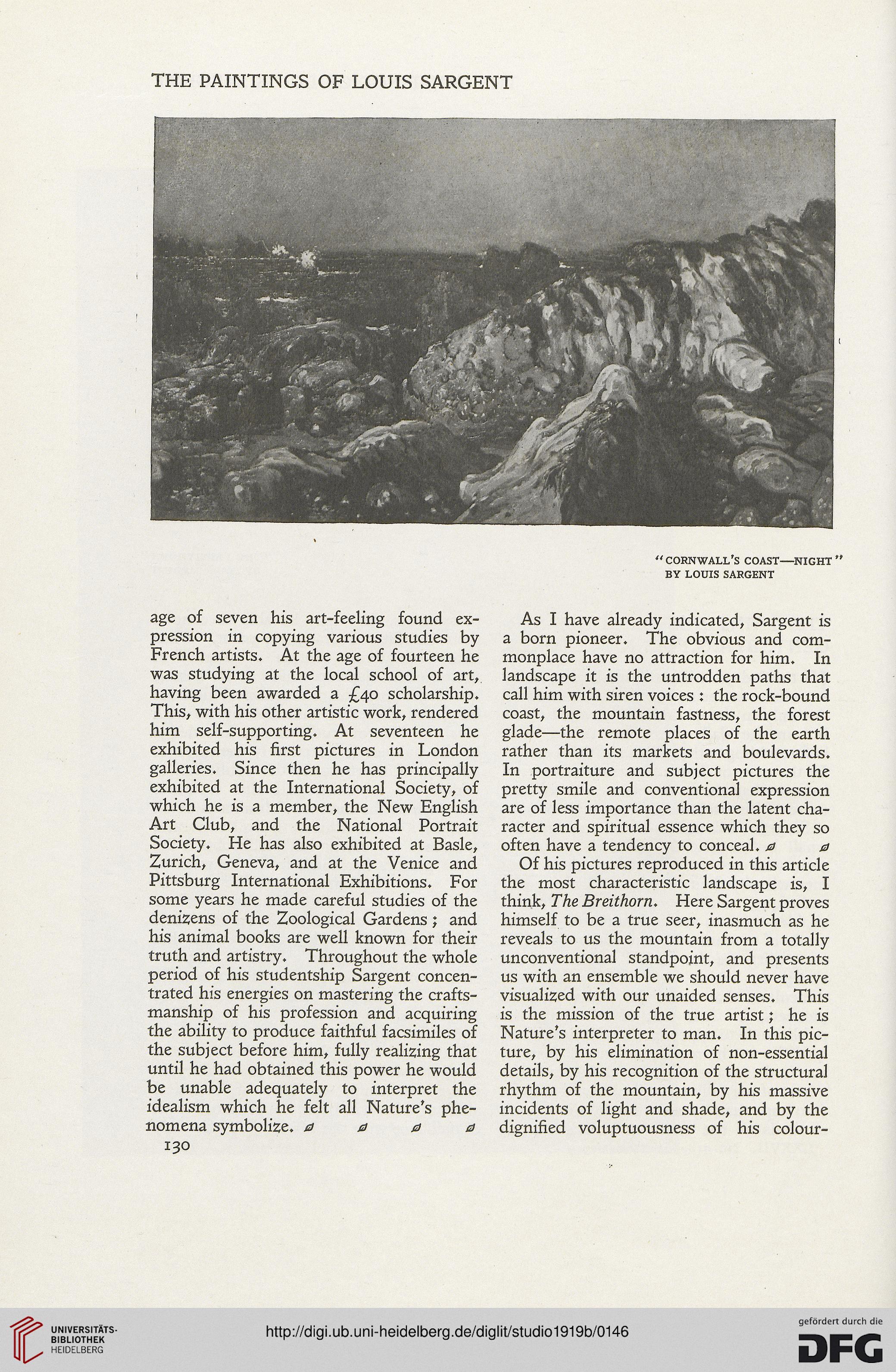THE PAINTINGS OF LOUIS SARGENT
“CORNWALL'S COAST—NIGHT”
BY LOUIS SARGENT
age of seven his art-feeling found ex-
pression in copying various studies by
French artists. At the age of fourteen he
was studying at the local school of art,
having been awarded a £40 scholarship.
This, with his other artistic work, rendered
him self-supporting. At seventeen he
exhibited his first pictures in London
galleries. Since then he has principally
exhibited at the International Society, of
which he is a member, the New English
Art Club, and the National Portrait
Society. He has also exhibited at Basle,
Zurich, Geneva, and at the Venice and
Pittsburg International Exhibitions. For
some years he made careful studies of the
denizens of the Zoological Gardens ; and
his animal books are well known for their
truth and artistry. Throughout the whole
period of his studentship Sargent concen-
trated his energies on mastering the crafts-
manship of his profession and acquiring
the ability to produce faithful facsimiles of
the subject before him, fully realizing that
until he had obtained this power he would
be unable adequately to interpret the
idealism which he felt all Nature's phe-
nomena symbolize. 0000
130
As I have already indicated, Sargent is
a born pioneer. The obvious and com-
monplace have no attraction for him. In
landscape it is the untrodden paths that
call him with siren voices : the rock-bound
coast, the mountain fastness, the forest
glade—the remote places of the earth
rather than its markets and boulevards.
In portraiture and subject pictures the
pretty smile and conventional expression
are of less importance than the latent cha-
racter and spiritual essence which they so
often have a tendency to conceal. 0 0
Of his pictures reproduced in this article
the most characteristic landscape is, I
think, The Breithorn. Here Sargent proves
himself to be a true seer, inasmuch as he
reveals to us the mountain from a totally
unconventional standpoint, and presents
us with an ensemble we should never have
visualized with our unaided senses. This
is the mission of the true artist; he is
Nature’s interpreter to man. In this pic-
ture, by his elimination of non-essential
details, by his recognition of the structural
rhythm of the mountain, by his massive
incidents of light and shade, and by the
dignified voluptuousness of his colour-
“CORNWALL'S COAST—NIGHT”
BY LOUIS SARGENT
age of seven his art-feeling found ex-
pression in copying various studies by
French artists. At the age of fourteen he
was studying at the local school of art,
having been awarded a £40 scholarship.
This, with his other artistic work, rendered
him self-supporting. At seventeen he
exhibited his first pictures in London
galleries. Since then he has principally
exhibited at the International Society, of
which he is a member, the New English
Art Club, and the National Portrait
Society. He has also exhibited at Basle,
Zurich, Geneva, and at the Venice and
Pittsburg International Exhibitions. For
some years he made careful studies of the
denizens of the Zoological Gardens ; and
his animal books are well known for their
truth and artistry. Throughout the whole
period of his studentship Sargent concen-
trated his energies on mastering the crafts-
manship of his profession and acquiring
the ability to produce faithful facsimiles of
the subject before him, fully realizing that
until he had obtained this power he would
be unable adequately to interpret the
idealism which he felt all Nature's phe-
nomena symbolize. 0000
130
As I have already indicated, Sargent is
a born pioneer. The obvious and com-
monplace have no attraction for him. In
landscape it is the untrodden paths that
call him with siren voices : the rock-bound
coast, the mountain fastness, the forest
glade—the remote places of the earth
rather than its markets and boulevards.
In portraiture and subject pictures the
pretty smile and conventional expression
are of less importance than the latent cha-
racter and spiritual essence which they so
often have a tendency to conceal. 0 0
Of his pictures reproduced in this article
the most characteristic landscape is, I
think, The Breithorn. Here Sargent proves
himself to be a true seer, inasmuch as he
reveals to us the mountain from a totally
unconventional standpoint, and presents
us with an ensemble we should never have
visualized with our unaided senses. This
is the mission of the true artist; he is
Nature’s interpreter to man. In this pic-
ture, by his elimination of non-essential
details, by his recognition of the structural
rhythm of the mountain, by his massive
incidents of light and shade, and by the
dignified voluptuousness of his colour-




